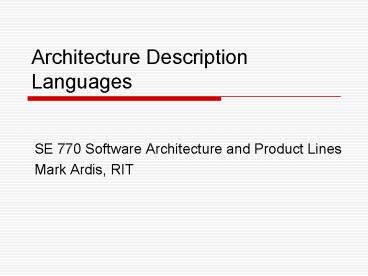Architecture Description Languages - PowerPoint PPT Presentation
1 / 16
Title:
Architecture Description Languages
Description:
Support describing a system at a higher level than previously possible ... Most ADL work today has been undertaken with academic rather than commercial goals in mind ... – PowerPoint PPT presentation
Number of Views:88
Avg rating:3.0/5.0
Title: Architecture Description Languages
1
Architecture Description Languages
- SE 770 Software Architecture and Product Lines
- Mark Ardis, RIT
2
Acknowledgements
- Most of these slides are taken from a
presentation by T. Cook of MCC (Microelectronics
and Computer Technology Corporation)
3
ADLs - Positives
- Represent a formal way of representing
architecture - Intended to be human and machine readable
- Support describing a system at a higher level
than previously possible - Permit analysis of architectures completeness,
consistency, ambiguity, and performance - Can support automatic generation of software
systems
4
ADLs - Negatives
- No universal agreement on what ADLs should
represent, particularly as regards the behavior
of the architecture - Representations currently in use are relatively
difficult to parse and are not supported by
commercial tools - Most ADL work today has been undertaken with
academic rather than commercial goals in mind - Most ADLs tend to be very vertically optimized
toward a particular kind of analysis
5
Object Connection Architecture
- Configuration consists of the interfaces and
connections of an object-oriented system - Interfaces specify the features that must be
provided by modules conforming to an interface - Connections represented by interfaces together
with call graph - Conformance usually enforced by programming
language
6
Object Connection Architecture
- The good news
- Mature development languages - C, Ada, Java
- Visual modeling and automatic code generation
tools - Standardized modeling language - UML
- The bad news
- Modules must be built before the architecture is
defined - Architecture not invariant under changes to
system - Conformance of a system to an architecture is
minimal - Can not be used to plan a system
7
Interface Connection Architecture
- Expands the role of interfaces and connections
- Interfaces specify both required and provided
features - Connections are defined between required
features and provided features - Consists of interfaces, connections and
constraints - Constraints restrict behavior of interfaces and
connections in an architecture - Constraints in an architecture map to
requirements for a system
8
Interface Connection Architecture
- The Good news
- Improved conformance of a system to an
architecture - Architecture can be built before modules are
implemented - The bad news
- No emerging standard
- Poor quality tools
- Most ADLs implement an interface connection
architecture.
9
ADLs Considered by MCC
- Leading candidates
- ACME (CMU/USC)
- Rapide (Stanford)
- Wright (CMU)
- Unicon (CMU)
- Secondary candidates
- Aesop (CMU)
- MetaH (Honeywell)
- C2 SADL (UCI)
- SADL (SRI)
10
ACME
- ACME was developed jointly by Monroe, Garlan
(CMU) and Wile (USC) - ACME is a general purpose ADL originally designed
to be a lowest common denominator interchange
language - ACME as a language is extremely simple (befitting
its origin as an interchange language)
11
Rapide
- Developed by David Luckham at Stanford
- Rapide is a general purpose ADL designed with an
emphasis on simulation yielding partially ordered
sets of events (posets) - Rapide as a language is fairly sophisticated,
including data types and operations - Rapide analysis tools focus on posets
- matching simulation results against patterns of
allowed/prohibited behaviors - some support for timing analysis
- focus on causality
12
Wright
- Developed by David Garlan at CMU
- Wright is a general purpose ADL designed with an
emphasis on analysis of communication protocols - Wright uses a variation of CSP to specify the
behaviors of components, connectors, and systems - CSP - Communicating Sequential Processes -
process algebra developed by C. A. R. Hoare - Wright as a language focuses primarily on the
basic component/connector/system paradigm - Wright is very similar syntactically to ACME and
Aesop - Wright analysis focuses on analyzing the CSP
behavior specifications. - Any CSP analysis tool or technique could be used
to analyze the behavior of a Wright specification
13
Aesop
- Developed by David Garlan at CMU
- Aesop is a general purpose ADL emphasizing
architectural styles - Aesop is also a toolset and a framework
- Aesop the ADL is very similar to ACME/Wright
- Emphasis on styles reflected in more
sophisticated hierarchical facilities centered
around subtyping and inheritance - Wright analysis focuses on analyzing the CSP
behavior specifications. - Any CSP analysis tool or technique could be used
to analyze the behavior of a Wright specification
14
Unicon
- Developed by Mary Shaw at CMU
- Unicon is a general purpose ADL designed with an
emphasis on generation of connectors - Unicon developed to support treatment of
connectors as first class objects by providing
for the generation of systems with explicit
connectors - Unicon as a language focuses primarily on the
basic component/connector/system paradigm but
with an emphasis on architectural styles - Emphasis on styles simplifies generation efforts
- Unicon has a generation capability
15
Others
- MetaH
- Developed by Honeywell, a domain specific ADL
aimed at guidance, navigation, and control
applications with ControlH - Sophisticated tool support available
- C2 SADL
- Developed by Taylor/Medvidovic (UCI), style
specific ADL, emphasis on dynamism - Still in prototype stage
- SADL
- Developed by Moriconi and Riemenschneider (SRI),
emphasis on refinement mappings
16
UML as an ADL
- The Positive
- lowers entry barrier, mainstreams modeling, tools
- Shortcomings of UML as an ADL
- Weakly integrated models with inadequate
semantics for (automated) analysis - Connectors are not first class objects
- Visual notation with little generation support,
hidden and ambiguous relationships between views,
both too much and too little































